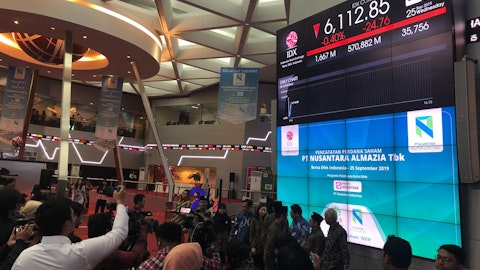In addition, OTA stands to gaining from increased online penetration. Although the business travel is typically more close tied to the economic activities and maybe impact by economic concerns, but we also see significant opportunities for us as more businesses will adopt managed corporate travel services to optimize their travel budget. For the second question, the sales and marketing expenses, our marketing efficiencies have seen significant improvement this year, primarily due to enhanced conversion and cross-selling efforts. Additionally, we made significant savings due to the strong release of pent-up demand. We do expect an increase in marketing spending as a percentage of revenue in the Q4 following a typical low seasonality in the next — in the fourth quarter, and also as part of our efforts to normalize the marketing spending to stimulate future growth.
And in the long run, we are quite consistently to have — to commit it to an ROI-driven marketing investment approach, striving to balance the efficiency gains and the long-term investment needs in the overseas markets as well as the opportunities in the lower-tier cities in China. And with regard to the competition with the content platform, I think, so far, what we observed, the competitive landscape in China domestic market is generally steady with some seasonal fluctuations in the marketing intensities among players. And I think OTA and content platform have totally different core competence. Content platform excel at producing creative content and sharing information, make them effective at promoting trending products. However, most of the content platform, they lack very strong back-end system to fulfill the booking capabilities, while OTA’s core competence in the — firstly, in the supplier chain — standard supplier chain and also, more importantly, the capabilities to provide reliable services.
Therefore, of course, we will always be sensitive in terms of the competition in the market. But at the end of the day, what we need to always focus is to strengthen — further strengthening our core competence. Thank you.
Operator: Next, we have Alex Yao from JP Morgan. Please go ahead.
Alex Yao: First of all, congrats on a rock solid quarter. Year-to-date, you guys have delivered very impressive margin improvement relative to the historical level. Can you talk us through how did you achieve the current margin structure? For example, can you break down the margin structure across domestic outbound, international — to international between now and the same period of 2019? And as we look into 2024, apparently, the outbound, which is a higher-margin business, will very likely outgrow the domestic business. How should we think about the margin structure into ‘24 and beyond? Thank you.
Cindy Wang: Thank you, Alex. In general, our — because we have very strong brand awareness and market share in the China market for both the China domestic as well as China outbound, we have very healthy margins to serving the China market. And in the international market, we grow very fast. But still at current stage, we are still in the investment cycle. But at the same time, we will balance the investment versus improving and toward a more healthy margin for the international market. Yes, you are correct. Moving into the year 2024, we think the outbound travel percentage as a percentage of the total revenue contribution to the whole group we’re definitely going forward. And outbound, traditionally is a more healthy or higher-margin business for us.
But I think the margin level that we achieved this year, there’s some special factors impacted because especially in the first half of this year, the strong rebound is, to some extent, out of our own expectation. So in terms of readiness on both the service as well as the sales and marketing, we have a comparatively limited preparation to serve the much — higher-than-expected outbound — rebound — market rebound. So to be honest, our operating margin, especially high operating margin especially for the first half of this year is even higher than the normalized level. So next year, with the business moving into a more normalized level, we should make investment — enough investment in both the service as well as the sales and marketing effort.
Our marketing expenditure will increase slightly to fuel the future growth of the business. Our margin level — operating margin level will trend down a little bit compared with first half of this year. But in general, there’s other factors like the increase of the outbound, and continuously improved margins in the international market will also help us to balance the total operating margin moving into the next year. So, in the longer period, we think we will definitely achieve — previously, we have — give guidance to our shareholders that to achieve the margin level toward like — to the 20% to 30% level. We already achieved that level this year, and we have the full confidence to continuously to maintain a healthy margin level moving forward.
Thank you.
Operator: Next, we have Jiong Shao from Barclays. Please go ahead. Thank you.
Jiong Shao: I have two, if I may. And let me add my congrats as well for the strong results. You have had, I think, at least three, four quarters of very strong results since the COVID restrictions got lifted. I think some of the investors are a bit worried that, oh, is this because the pent-up demand jump, and then growth would be tapering off like some of your peers have seen in the west. I was hoping you could share with us your thoughts about why sort of that’s not going to be the case, why the growth — you mentioned about growth to continue in ‘24 and beyond. If you can share with us your thoughts around the longer term sort of three-year horizon growth drivers, growth rate, that would be great. And a related question to the margin question you just expanded earlier.





